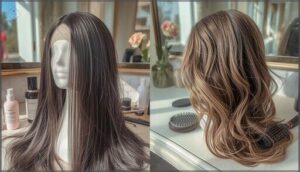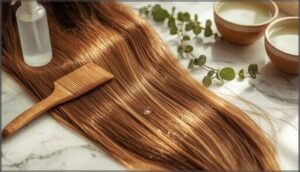This site is supported by our readers. We may earn a commission, at no cost to you, if you purchase through links.

Your new human hair wig looked impeccable for the first few weeks, but now it’s lost that salon-fresh bounce and feels heavier than usual. The culprit? You’re likely washing it either too often or not enough.
Most wig wearers don’t realize that overwashing strips away protective coatings while underwashing creates buildup that suffocates the fibers. The washing frequency that works for your natural hair won’t translate to your wig, and getting this balance wrong can cut your investment’s lifespan in half.
Finding the right rhythm depends on your wig type, how often you wear it, and your daily activities—factors that create an individual care schedule rather than a one-size-fits-all rule.
Table Of Contents
Key Takeaways
- Wash human hair wigs every 7-10 wears (or 5-7 if worn daily), while synthetic wigs need washing after 6-10 wears to balance fiber protection against product buildup and odor.
- Your washing schedule depends on personal factors like activity level, climate, styling product usage, and wig density—heavy product users and high-activity wearers need more frequent washing than occasional wearers.
- Watch for warning signs like visible buildup, persistent odor, increased tangling, dullness, or scalp irritation as clear indicators your wig needs immediate washing regardless of your regular schedule.
- Always use lukewarm water with sulfate-free products, detangle before washing, apply conditioner only to mid-lengths and ends, and air dry on a stand to prevent the most common mistakes that shorten wig lifespan.
How Often Should You Wash Your Hair Wigs
Getting the washing schedule right can feel like walking a tightrope—wash too often and you’ll damage the fibers, but wait too long and buildup takes over. The answer isn’t one-size-fits-all because it depends on whether you’re wearing human hair or synthetic, plus how often that wig actually sits on your head.
Finding the right wig washing schedule is a balancing act between preventing damage and avoiding buildup
Let’s break down the specifics so you can create a washing routine that keeps your wig fresh without wearing it out.
Recommended Frequency for Human Hair Wigs
Generally, you should wash your human hair wig every 7–10 wears to maintain its natural shine and softness. If you wear it daily or use heavy styling products, adjust your washing schedule to every 5–7 wears. For occasional use, washing once every 2–4 weeks works well.
Following the right washing frequency protects your investment and keeps your wig looking fresh. Remember to factor in lifestyle and hair density when deciding on a washing schedule.
Washing Schedule for Synthetic Wigs
Synthetic wigs follow a different rhythm than human hair. You’ll want to wash your synthetic wig after every 6–10 wears to control odor and product buildup without damaging the fibers. If you wear it daily, aim for washing every 1–2 weeks. Rarely worn wigs can stretch to 4–6 weeks between washes.
Fiber type and seasonal changes also influence your schedule. Remember that excessive washing can alter the texture.
How Wear Frequency Affects Washing
Daily wear demands more attention than occasional cleaning—it’s just reality. If you’re wearing your human hair wig every day, plan on washing every 5–7 wears to combat product buildup and environmental factors.
Occasional wearers can stretch to 10–14 wears between washes. Your washing frequency directly mirrors wear impact: more exposure means faster accumulation of oils, styling products, and pollutants that dull your wig’s appearance.
Factors That Influence Wig Washing Frequency
Your wig’s washing schedule isn’t one-size-fits-all. Several key factors determine how often you’ll need to clean your wig to keep it looking fresh and natural.
Let’s explore what influences your specific washing frequency.
Activity Level and Lifestyle
Your activity level plays a major role in washing frequency and wig care. If you sweat from exercise or outdoor work, you’ll need to wash every 5-7 wears to prevent product buildup and odor. Daily wear in urban environments with pollution exposure requires weekly washing.
Using a wig cap helps absorb sweat, potentially extending your wig lifespan while maintaining proper hair maintenance between washes.
Climate and Environmental Conditions
Where you live dramatically affects washing frequency factors. Hot and humid area conditions push you toward washing every 5-7 wears due to moisture and sweat.
Air pollution in cities accelerates product buildup and scalp irritation, requiring more frequent cleaning.
Temperature control matters too—winter’s dry air extends intervals to 10-12 wears, while summer humidity and environmental factors demand closer attention to seasonal care.
Product Usage and Styling Habits
If you regularly reach for hairsprays, gels, or heat-protectant sprays, expect to wash every 6-8 wears. Heavy styling products create product buildup that dulls your wig and accelerates tangling—nearly three-quarters of maintenance issues stem from improper removal of these residues.
Application practices matter too: concentrate products on mid-lengths and ends, avoiding the cap to minimize safety implications and extend your wig’s lifespan.
Wig Density and Length Considerations
Density effects and length influence play critical roles in your washing protocols. Higher-density wigs trap more product and debris, requiring attention every 7-9 wears, while lower densities stretch to 10-12 wears.
Product absorption rates increase with hair density, making seasonal adjustments essential for wig care and human hair wig longevity.
- 200% density: Wash every 7-9 wears
- 150-180% density: Wash every 8-10 wears
- Below 150% density: Wash every 10-12 wears
- Long wigs: Wash every 7-9 wears regardless
- Shorter styles: Extend intervals by 2-3 wears
Signs Your Wig Needs Washing
Your wig will tell you when it’s time for a wash if you know what to look for. Waiting too long between washes can lead to problems that affect both the wig’s appearance and your comfort.
Here are the clear warning signs that your wig needs immediate attention.
Buildup, Odor, and Dullness
Your wig’s telling you something when it starts looking tired. Product residue creates a sticky, heavy feel—83% of wearers notice visible buildup after just five wears without washing.
Odor prevention becomes essential around the 7-10 wear mark, when 71% detect unpleasant smells.
Watch for dullness too; environmental exposure strips luster faster in high-density wigs, making regular washing frequency essential for restoration.
Increased Tangling or Matting
Tangles that won’t budge signal your human hair wig desperately needs attention. When fibers start knotting mid-shaft or friction-induced matting appears at the nape, you’re past due for washing—studies show improper wig care increases matting incidents by 35%.
Watch for these red flags:
- Knots forming despite gentle brushing with wide-tooth combs
- Resistance when detangling, especially in wigs over 18 inches
- Clumping at stress points where incorrect grooming tools were used
- Persistent tangles even after applying leave-in treatments
Environmental influences like humidity and daily friction accelerate fiber damage. Preventive practices matter—regular wig washing frequency paired with proper wig maintenance protects your investment while keeping tangling manageable.
Scalp Discomfort or Irritation
Itching, burning, or redness under your wig? You’re experiencing what 73% of synthetic hair wearers report—early irritation signs often stemming from product buildup restricting airflow.
Poor hygiene practices, allergic reactions to adhesives, or fit issues create scalp health problems. Product residue traps heat and bacteria, demanding gentle cleansing.
Severe conditions like persistent inflammation warrant medical attention, especially when discomfort lasts beyond two weeks.
Step-by-Step Guide to Washing Your Wig
Washing your wig properly makes all the difference between keeping it vibrant and shortening its lifespan. The process isn’t complicated, but following the right steps protects your investment and keeps your wig looking natural.
Here’s exactly how to wash your wig from start to finish.
Pre-Wash Preparation and Detangling
Before washing, you’ll want to detangle your wig carefully using a wide-tooth comb or soft-bristle brush. Start at the ends and work upward toward the roots—this gentle combing method prevents fiber damage and reduces shedding by up to 40%.
Mist tangled areas with a wig-friendly detangling spray, then pre-soak the wig in lukewarm water for 3-10 minutes to loosen buildup without stressing the fibers.
Proper Washing Techniques for Human Hair Wigs
Once you’ve finished detangling, fill a basin with lukewarm water and add sulfate-free shampoo. Gently swish your wig through the water—don’t scrub or twist the fibers.
Here’s what matters most:
- Apply shampoo in downward strokes, following the hair’s natural direction
- Avoid hot water which damages fibers and shortens lifespan
- Never apply product directly to the cap area
Rinse thoroughly with cool water to seal the cuticle.
Conditioning and Drying Best Practices
After rinsing, apply a leave-in conditioner from mid-lengths to ends—never the cap—to lock in hair moisture and prevent product buildup. Gently pat excess water with a microfiber towel, then place your wig on a stand for air drying.
This wig drying technique protects against heat damage while supporting moisture retention. Consider deep conditioning treatments every 4-6 weeks to maintain softness and manageability throughout the wig conditioning process.
Washing Mistakes to Avoid
Even with perfect drying, common wig washing mistakes can undo your care efforts. Skipping detangling before washing causes up to 80% of wig damage prevention issues through fiber breakage.
Water temperature matters—hot water permanently alters synthetic fibers and damages human hair cuticles.
Using regular shampoo instead of wig-specific products accelerates dryness by 57%, while aggressive brushing when wet doubles breakage rates.
Essential Tips for Maintaining Wig Freshness
Washing your wig properly is only half the battle—maintaining its freshness between washes requires the right products, storage habits, and care strategies. Think of these practices as your wig’s daily routine, keeping it looking salon-fresh without constant washing.
Let’s cover the essentials that’ll help your investment stay beautiful and last longer.
Recommended Products for Wig Care
Your wig deserves products designed specifically for its unique needs. Using the right wig washing products protects your investment and maintains that fresh, natural look between washes.
- Sulfate-free shampoos: Pure Care Wig Shampoo and ELC Pure Olove reduce matting while preserving softness
- Wig conditioners: Moroccan Oil delivers glossy results; Purelogy maintains vibrant colors
- Detangling sprays and leave-in treatments: HD Smooth Detangler prevents tangling in synthetic fibers
- Wide-tooth combs: Essential for gentle detangling without damaging delicate wig fibers
Proper Storage Between Washes
Between washes, proper storage protects your investment from unnecessary wear. Always place your wig on a canvas or foam wig stand in a cool, dry location—humidity control prevents frizzing and matting.
Gently detangle before storing using wide-tooth combs, working from ends upward. These wig storage techniques maintain shape while promoting airflow, essential damage prevention steps that keep your wig fresh and ready to wear.
Strategies for Extending Wig Longevity
To get the most from your investment, adopt habits that shield your wig from premature aging. Proper wig care requires mindful decisions about heat styling, chemical treatments, and daily handling.
- Rotate between multiple wigs—this simple practice extends each piece’s lifespan by approximately 60%
- Limit heat styling tools and always apply protection sprays on low settings
- Skip chemical treatments like bleaching that compromise hair integrity
- Use specialized products including hydrating serums and wig-specific conditioners after washing
Frequently Asked Questions (FAQs)
Can I swim with my wig on?
Sure, you can take a dip—but the irony is that water, meant to cleanse, actually damages wigs through chlorine damage and saltwater effects.
Human hair wig types tolerate brief exposure better than synthetic, but both need post-swim care immediately.
How to remove stubborn buildup from wigs?
Soak your wig in cool water with gentle wig shampoo to dissolve buildup. For stubborn residue, try vinegar rinses or rubbing alcohol on lace sections.
Always detangle carefully, then deep condition to restore moisture after intensive wig cleaning.
Do lace front wigs need special washing?
Your stylist once replaced a client’s torn lace after she scrubbed too hard during washing. Lace front wigs demand gentler handling than standard wigs.
Remove adhesive residue carefully before washing, avoid aggressive scrubbing near knots, and air dry on stands to preserve delicate lace integrity.
What water temperature is safest for wigs?
Cool water protects synthetic wigs from melting, while warm water works best for human hair wigs.
Hot water damages both types by stripping moisture and weakening fibers, so always avoid extreme temperatures.
Can I use dry shampoo on wigs?
Yes, you can use dry shampoo on wigs—both human hair and synthetic—but application techniques matter.
Spray lightly from 10-12 inches away, focusing on roots to absorb oils without causing buildup or damaging delicate fibers.
Conclusion
Your wig’s lifespan isn’t determined by how much you paid for it—it’s shaped by how well you understand its care rhythm. Overwashing strips away protection, while underwashing invites damaging buildup.
Now that you know how often you should wash your hair wigs based on your unique wear patterns and lifestyle, you’re equipped to maintain that salon-fresh appearance month after month. The right washing schedule transforms your investment from temporary accessory into long-lasting confidence.
- https://haireveryday.com/how-often-should-i-wash-my-hair-brush/
- https://www.lorealparisusa.com/beauty-magazine/hair-care/all-hair-types/wide-tooth-comb-benefits
- https://www.self.com/story/sulfate-free-shampoo
- https://www.wigs.com/blogs/news/how-often-should-i-wash-my-wig
- https://www.keswigs.com/blogs/guides/how-often-should-you-wash-your-human-hair-wig










